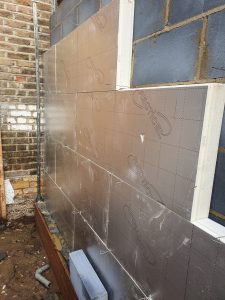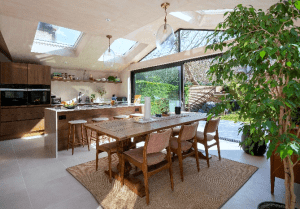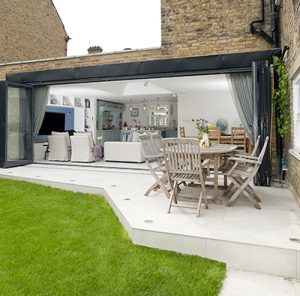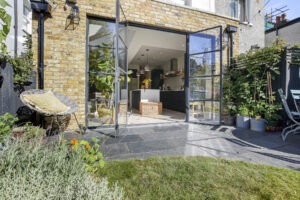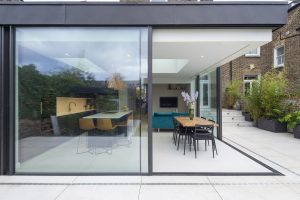As energy prices remain unpredictable and the temperatures will soon start to drop, UK homeowners in 2025 are prioritising comfort, efficiency, and sustainability. When it comes to home renovation, heating and energy efficiency are top of the list of most important things to consider.
Whether you’re planning a major renovation or just refreshing a few areas, taking steps to keep your home warm in winter and cool in summer can make a big difference. With new technology, updated energy regulations and innovative materials now widely available, keeping your home warm doesn’t have to mean sky-high bills.
Here are the top 10 smart, cost-effective ways to heat your home this winter.
1. Insulate using Modern, Low-Carbon Materials

Did you know that up to a quarter of your home’s heat can escape through the roof? Insulation is still the first and most effective line of defence against heat loss. Insulating your loft to the recommended minimum depth of 270mm is a practical first step that can significantly enhance your home’s comfort. Don’t forget to insulate between the joists and to draught proof your loft hatch to prevent warm air from escaping.
Beyond the roof, consider insulating your walls and floors. Filling any gaps will not only reduce heat loss but also create a cosier space. A well-insulated home isn’t just warmer – it’s more cost-effective in the long run, saving on energy bills and importantly, reducing your environmental footprint. In 2025, the material choice of efffective insulating materials has significantly evolved.
- Phase Change Materials (PCMs): These innovative insulators absorb and release heat as temperatures change, and this helps to regulate indoor warmth.
- Natural Insulation Options: Hempcrete, wood fibre, sheep wool, and cellulose are all now widely available. They all provide excellent thermal performance with minimal embodied carbon.
If you are planning to insulate your roof, check if there are any retrofit grants available locally that support natural insulation materials.
Whilst you are thinking about insulation, consider draught proofing as even the smallest gaps can let in a surprising amount of cold air. Begin with the doors and windows – install draught proofing strips around the frames to seal any gaps. For doors, adding draught excluders along the bottom edge can make adifference too. Don’t forget keyholes and letterboxes.
2. Upgrade to Heat Pumps or Hybrid Heating Systems
Gas boilers are on the way out. Even if you’re planning a minor renovation or a small extension, upgrading your boiler is definitely worth considering. Older boilers might struggle to heat an expanded space, whereas newer alternatives are designed to be more energy efficient, saving you money on your heating bills.
In 2025, many homeowners are choosing air source or ground source heat pumps as these are now more accessible and often subsidised through local or national incentives. Hybrid Systems are also worth considering. These combine a heat pump with a traditional boiler to offer both efficiency and reliability in colder climates.
Whichever system you choose,can add value to your property, an added benefit if you’re considering selling in the future. Opt for a model that is compatible with smart thermostats and time-of-use tariffs to maximise savings on your heating bills.
Check if you are eligible for a grant in the government boiler upgrade scheme. These grants contribute towards the cost of boiler upgrades.
3. Use Zoned Heating and Smart Controls

Modern smart home technology is transforming the way we heat our homes, making it more efficient and cost-effective. Smart thermostats like Hive, Tado, or Nest learn your habits and can adjust the temperature in different rooms, based on your routine, occupancy and the weather in your area. Plus, being able to control your heating from your smartphone -wherever you are- allows for maximum flexibility.
Additionally, thermostatic radiator valves and zoned heating systems allow you to customise the heating in individual rooms independently, minimising wasted energy – why heat the whole house if you don’t need to?
If you are planning to install heating in your new extension or upgrade the system in your main house, many newer systems are eligible for ECO+ scheme support or at local council level – retrofit funding.
4. Upgrade to Smart Glazing
Upgrading your windows and doors with energy efficient solutions can make a significant difference to your home’s warmth and energy usage. 2025 options have progressed from double and triple glazing. Options now include Smart Glass which is solar control glazing that can auto-adjust to light and temperature. This helps to reduce heat loss in winter and overheating in summer.
When choosing glazing, bear in mind U-Value Goals. The aim is for the glazing to have U-values under 0.8 W/m²K – this is in line with Passive House standards and represents the best thermal performance.
5. Harness Creative Glazing and Solar Gain

Daylight matters and is well worth considering when planning the design for a new extension – for example, south-facing glazing still offers the best natural heating potential.
An increasing number of homes in the UK are using photovoltaic (solar) glazing. These are transparent solar panels installed in skylights and windows. If you are seeking strategies for controlling the amount of sunlight in certain rooms, roof overhangs, pergolas and external blinds can all be successfully used to manage the sunlight.
6. Maximise Efficiency using Smart Lighting

LED technology and efficiency has improved dramatically in the last few years and now offers homeowners better dimming and colour accuracy. Installing a smart lighting system makes good sense as LED efficient bulbs can be operated by a programmable schedule and paired with motion sensors, daylight sensors and voice controls to minimise energy waste.
When designing the lighting for a space, remember the well-known trick that well-placed lighting can enhance thermal comfort psychologically, making a space feel warmer. Make sure that you have good app integration connecting energy data from your lighting with heating and key appliances to ensure full home optimisation.
7. Use A-Rated Appliances
New appliance models in 2025 are smarter and significantly more efficient than older ones. A-G Labels: The UK’s post-2021 label system – A-G Labels- makes it easier to identify which are truly energy-efficient machines. Many also have Smart AI, for example some dishwashers, dryers and heaters are now fitted with auto-adjust cycles based on energy pricing or usage history.
8. Invest in Solar PV and Battery Storage

Even in winter, solar panels linked to batteries can reduce your reliance on the grid- especially for heating support systems.
If you are planning a new extension, choose a solar ready roof design. Even if you are not installing PV immediately, orienting and angling your roof correctly will save time and money when you come to install it. Having a battery system is a real bonus -if you have the space – as the batteries store excess energy during the day that can be used at night- when most homes require more heating.
9. Manage Water More Efficiently
A large portion of your energy bills will be for using water. In 2025 water conservation makes sense. Encourage family members to not let the hot water tap for ages and to take shorter showers. Make sure any leaks are promptly repaired. Smart water monitors like Phyn or Grohe Sense Guard track usage and catch costly leaks early.
Greywater recycling is gathering traction. This is the reuse of shower and sink water for flushing the toilet toilet and garden irrigation.
10. Monitor and Optimise with Home Energy Systems
Modern energy monitors help homeowners to understand and improve their use of energy. Smart energy monitors like Loop, Sense and Geo Trio II all show real-time energy usage and suggest ways to reduce waste.
Summary
Winters in the UK are not getting any milder, but homes are geting smarter. By combining proven strategies like insulation and zone heating with 2025 upgrades like AI appliances, smart glazing and solar pairing, you can keep your house warm without overspending or over-polluting.
If you are planning a new extension or modernisation for your home, do not just think of energy efficiency but consider low-carbon construction choices using recycled or renewable materials when upgrading windows, floors, or insulation. All these factors will pay off in comfort, lower bills and long-term resilience.
Whether it’s improving insulation, upgrading your glazing or installing smart technology, these changes will all help to make the difference. If you’re ready to take the next step or are simply in need of some advice to prepare for the colder months, why not get in touch with us at Build Team today?





